"Fire Watch" is a science fiction novelette by American writer Connie Willis. The story, first published in Isaac Asimov's Science Fiction Magazine in February 1982, [1] involves a time-traveling historian who goes back to the Blitz in London, to participate in the fire lookout at St. Paul's Cathedral.
The narrator is a student historian from a future where historians use time-travel to study history directly. He had prepared himself to visit St. Paul in the first century but instead gets sent to St. Paul's Cathedral in 1940. He develops a deep emotional attachment to the cathedral and is highly devoted to his role in defending it – especially due to his bitter knowledge that St. Paul's would survive the World War II bombings but would be obliterated in a terrorist attack nearer to the protagonist's own time.
The story won both a Hugo Award for Best Novelette and a Nebula Award for Best Novelette. [2]
"Fire Watch" (1982) was included in Willis' short-story collections Fire Watch (1984) and The Best of Connie Willis: Award-Winning Stories (2013). [3]
The idea of a time-traveling history department at Oxford University, introduced in this novelette, was also used in her later novels Doomsday Book (1992), To Say Nothing of the Dog (1997), and Blackout/All Clear (2010), as was the character of Professor James Dunworthy.
Although Willis' writing of "Fire Watch" predates the production of Doomsday Book by about a decade, Kivrin Engle, the main character of Doomsday Book, also appears as a minor character in "Fire Watch". The novelette references Engle's experience with the Black Plague while time-traveling in the 14th century.

Asimov's Science Fiction is an American science fiction magazine which publishes science fiction and fantasy named after science fiction author Isaac Asimov. It is currently published by Penny Publications. From January 2017, the publication frequency is bimonthly.
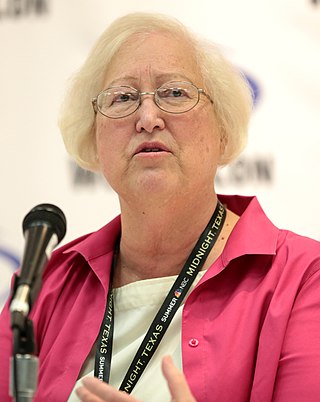
Constance Elaine Trimmer Willis, commonly known as Connie Willis, is an American science fiction and fantasy writer. She has won eleven Hugo Awards and seven Nebula Awards for particular works—more major SF awards than any other writer—most recently the "Best Novel" Hugo and Nebula Awards for Blackout/All Clear (2010). She was inducted by the Science Fiction Hall of Fame in 2009 and the Science Fiction Writers of America named her its 28th SFWA Grand Master in 2011.
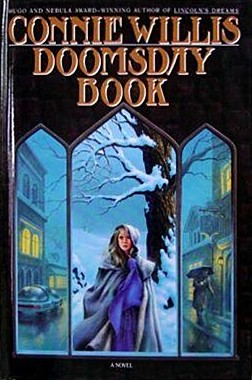
Doomsday Book is a 1992 science fiction novel by American author Connie Willis. The novel won both the Hugo and Nebula Awards, and was shortlisted for other awards. The title of the book refers to the Domesday Book of 1086. Kivrin Engle, the main character, says that her recording is "a record of life in the Middle Ages, which is what William the Conqueror's survey turned out to be."

Fire Watch is a book of short stories by Connie Willis, first published in 1984, that touches on time travel, nuclear war, the end of the world, and cornball humour.

Dr. Phil D’Amato is the central character in three science fiction mystery novelettes and three novels written by Paul Levinson. The first novelette, "The Chronology Protection Case", was adapted into a radio play which was nominated for an Edgar Award by the Mystery Writers of America. The first novel, The Silk Code, won the Locus Award for the Best First Novel of 1999. The fictional D'Amato, who has a PhD in forensic science, is a detective with the NYPD.
The 41st World Science Fiction Convention (Worldcon), also known as ConStellation, was held on 1–5 September 1983 at the Baltimore Convention Center in Baltimore, Maryland, United States.
The New Hugo Winners was a series of books which collected science fiction and fantasy short-form works that had recently won a Hugo Award for best Short Story, Novelette or Novella. Published by Baen Books, the series succeeded Doubleday's The Hugo Winners following that series' discontinuation after volume five. The New Hugo Winners ran for four volumes, published in 1989, 1992, 1994, and 1997, together collecting stories that had won the award from 1983 to 1994. The first two volumes were edited by Isaac Asimov. Due to Asimov's death in April 1992, the third volume was edited by Connie Willis and the fourth by Greg Benford.

The Nebula Awards #18 is an anthology of science fiction short works edited by American writer Robert Silverberg. It was first published in hardcover by Arbor House in October 1983; a paperback edition with cover art by Gary LoSasso was issued by Bantam Books in September 1984.

Terry Carr's Best Science Fiction of the Year is an anthology of science fiction short stories edited by Terry Carr, the fourteenth volume in a series of sixteen. It was first published in paperback by Tor Books in July 1985, and in hardcover and trade paperback by Gollancz in October of the same year, under the alternate title Best SF of the Year #14.
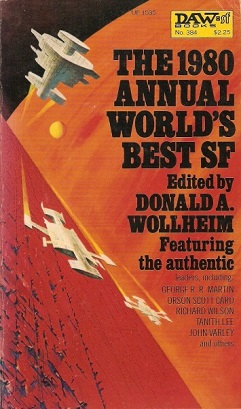
The 1980 Annual World's Best SF is an anthology of science fiction short stories edited by Donald A. Wollheim and Arthur W. Saha, the ninth volume in a series of nineteen. It was first published in paperback by DAW Books in May 1980, followed by a hardcover edition issued in September of the same year by the same publisher as a selection of the Science Fiction Book Club. For the hardcover edition the original cover art of Jack Gaughan was replaced by a new cover painting by Gary Viskupik. The paperback edition was later reissued by DAW under the variant title Wollheim's World's Best SF: Series Nine.

The 1983 Annual World's Best SF is an anthology of science fiction short stories edited by Donald A. Wollheim and Arthur W. Saha, the twelfth volume in a series of nineteen. It was first published in paperback by DAW Books in May 1983, followed by a hardcover edition issued in September of the same year by the same publisher as a selection of the Science Fiction Book Club. For the hardcover edition the original cover art was replaced by a new cover painting by Richard Powers.

The 1985 Annual World's Best SF is an anthology of science fiction short stories edited by Donald A. Wollheim and Arthur W. Saha, the fourteenth volume in a series of nineteen. It was first published in paperback by DAW Books in June 1985, followed by a hardcover edition issued in September of the same year by the same publisher as a selection of the Science Fiction Book Club. For the hardcover edition the original cover art by Frank Kelly Freas was replaced by a new cover painting by Richard Powers.

The 1986 Annual World's Best SF is an anthology of science fiction short stories edited by Donald A. Wollheim and Arthur W. Saha, the fourteenth volume in a series of nineteen. It was first published in paperback by DAW Books in June 1986, followed by a hardcover edition issued in August of the same year by the same publisher as a selection of the Science Fiction Book Club. For the hardcover edition the original cover art by Vincent Di Fate was replaced by a new cover painting by Ron Walotsky.

The 1989 Annual World's Best SF is an anthology of science fiction short stories edited by Donald A. Wollheim and Arthur W. Saha, the eighteenth volume in a series of nineteen. It was first published in paperback by DAW Books in June 1989, followed by a hardcover edition issued in September of the same year by the same publisher as a selection of the Science Fiction Book Club. For the hardcover edition the original cover art by Jim Burns was replaced by a new cover painting by Richard M. Powers.

The Best Science Fiction of the Year #12 is an anthology of science fiction short stories edited by Terry Carr, the twelfth volume in a series of sixteen. It was first published in paperback by Pocket Books in July 1983, and in hardcover by Gollancz in the same year.
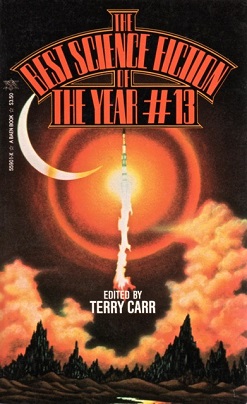
The Best Science Fiction of the Year #13 is an anthology of science fiction short stories edited by Terry Carr, the thirteenth volume in a series of sixteen. It was first published in paperback by Baen Books in July 1984, and in hardcover and trade paperback by Gollancz in December of the same year.

Terry Carr's Best Science Fiction of the Year #15 is an anthology of science fiction short stories edited by Terry Carr, the fifteenth volume in a series of sixteen. It was first published in paperback by Tor Books in August 1986 and in hardcover and paperback by Gollancz in October of the same year, under the alternate title Best SF of the Year #15.
This is a bibliography of American science fiction author Kim Stanley Robinson.
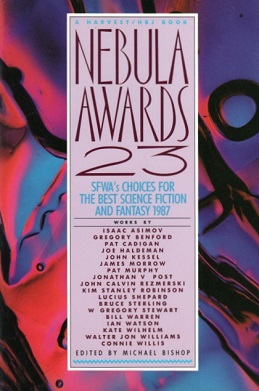
Nebula Awards 23 is an anthology of award winning science fiction short works edited by Michael Bishop, the first of three successive volumes under his editorship. It was first published in hardcover and trade paperback by Harcourt Brace Jovanovich in April 1989.